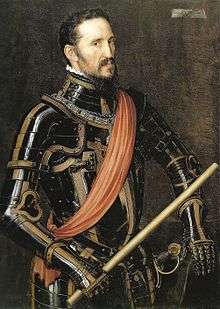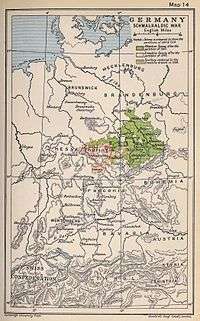Schmalkaldic War
| Schmalkaldic War | |||||||
|---|---|---|---|---|---|---|---|
 Titian's Equestrian Portrait of Charles I of Spain and V of the Holy Roman Empire (1548) celebrates Charles' victory at the Battle of Mühlberg. | |||||||
| |||||||
| Belligerents | |||||||
|
|
Other German territories | ||||||
| Commanders and leaders | |||||||
|
|
| ||||||
The Schmalkaldic War (German: Schmalkaldischer Krieg) refers to the short period of violence from 1546 until 1547 between the forces of Emperor Charles V of the Holy Roman Empire (simultaneously King Charles I of Spain), commanded by Don Fernando Álvarez de Toledo, Duke of Alba, and the Lutheran Schmalkaldic League within the domains of the Holy Roman Empire.
Background
In the course of the Lutheran Reformation numerous Imperial States had adopted the new confession, against the opposition of the ruling Catholic House of Habsburg, who recognised these conversions as a quest for increasing autonomy to the detriment of the central Imperial authority. At the 1521 Diet of Worms Emperor Charles V had Martin Luther banned and the proliferation of his writings prohibited, which in 1529 provoked the Protestation at Speyer by several Lutheran estates. The tensions culminated to an open conflict over the Lutheran Augsburg Confession of 1530, the Apology of which, written by Philipp Melanchthon, was rejected by the Emperor. In turn several Lutheran states led by Elector John Frederick I of Saxony and Landgrave Philip I of Hesse met at the town of Schmalkalden, where they established the Schmalkaldic League in 1531.
In 1544 Charles V returned to Germany from the Italian War after he had signed the Treaty of Crépy and began to forge alliances not only with Pope Paul III but also with Lutheran princes, foremost with Duke Maurice of Saxony, the Albertine cousin of Saxon Elector John Frederick I. In view of the Emperor's preparations for battle, the Schmalkaldic leaders on 4 July 1546 gathered at Ichtershausen and agreed that a preventive strike would be advisable, as long as Charles V had not concentrated a significant amount of mercenaries.
The Emperor gathered an army of around 52,000 men (20,000 Germans, 12,000 Italians, 10,000 Spaniards and 10,000 men from the Netherlands) for his campaign, that was to start on the Danube.[2]
Chronology
The war broke out in Swabia when a united army of several Lutheran Imperial cities occupied the Catholic town of Füssen, a possession of the Augsburg prince-bishops, and made the Imperial forces move toward the fortress of Ingolstadt in the Bavarian duchy. However, plans to invade Austrian Tyrol in order to bar the Emperor from bringing up Italian troops did not meet the approval of the Schmalkaldic princes. Both Duke William IV of Bavaria and the Austrian Archduke Ferdinand I of Habsburg declared themselves neutral in the conflict, allowing Charles V to concentrate a mighty Imperial army without disturbances.

Further on the Schmalkaldic leaders could not resolve upon delivering a battle against the entrenched Imperial troops. On 20 July 1546 Elector John Frederick I and Landgrave Philip I were placed under the Imperial ban, under the pretext that they had deposed the Catholic Duke Henry V of Brunswick-Wolfenbüttel in 1542. Duke Maurice of Saxony took the chance and in October with the aid of Ferdinand I of Habsburg, King of Bohemia, invaded the lands of his rival and cousin in Ernestine Saxony, forcing Elector John Frederick I to turn his troops around. He quickly came on from Swabia and liberated Ernestine Saxony with his army, whereafter he in turn invaded Albertine Saxony and the adjacent Bohemian lands. The onset of winter left the armed conflict inconclusive.
In Swabia the Hessian troops took no further action, while the forsaken Imperial cities, like the Lutheran princes Duke Ulrich of Württemberg and Count Palatine Frederick II chose to submit to the Emperor. On 28 March 1547 Charles V set off for Bohemia, where he united forces with his brother King Ferdinand I of Bohemia. Because the Bohemian Lutherans did not provide any military assistance to Elector John Frederick I, as he had hoped for, the Spanish-Imperial forces of Charles V forced him into retreat. Due to disagreement in strategy, the League's defenses were finally routed on 24 April 1547 at the Battle of Mühlberg, where John Frederick I was taken prisoner.
After the battle, which determined the result of the war, only two cities continued to resist: Bremen and Magdeburg. Both cities refused to pay the fines Charles imposed on them and avoided occupation by Imperial troops. In the case of Bremen, 12,000 imperial soldiers under the command of Duke Eric II of Brunswick-Calenberg unsuccessfully laid siege from January until May. This event led to the Battle of Drakenburg on 23 May 1547, as a Protestant army of the Schmalkaldic League was plundering the nearby Principality of Calenberg. His men and supplies exhausted, Duke Eric II and his Imperial forces went to confront the army and were quickly defeated. During the fighting, Eric was forced to swim over the Weser river in order to save his own life. As a consequence of the Battle of Drakenburg, the Imperial troops left northern Germany.
Aftermath


The captured Elector John Frederick I at first was sentenced to death, and, in order to obtain pardon, on 19 May 1547 signed the Capitulation of Wittenberg.[3] He lost the electoral dignity and some minor Ernestine territories to his cousin Maurice, who was declared the new Saxon Elector on 4 June. Maurice with the aid of Elector Joachim II Hector of Brandenburg tried to mediate in favour of his father-in-law Philip I of Hesse. The Landgrave delivered himself up in Halle, where he threw himself on the mercy of the Emperor. Charles V nevertheless had him immediately imprisoned, leaving the Electors upset by his haughty behaviour.
Although the Imperial forces were victorious over the Protestant forces of the Schmalkaldic League, crushing the heretics for the Pope in Rome, the ideas of Martin Luther had spread over the Empire such that they could not be suppressed with physical force. However, on 15 May 1548 Charles V, feeling at the height of his power, dictated the Augsburg Interim to prepare the reintegration of the Protestants into the Catholic Church. The edict provoked another revolt by the Protestant princes in 1552, this time led by Elector Maurice of Saxony and backed by King Henry II of France. Charles V had to flee from the superior Lutheran forces and to cancel the Interim with the Peace of Passau, whereby John Frederick I of Saxony and Philip I of Hesse were released. An official settlement acknowledging the Protestant religion arrived three years later in the form of the Peace of Augsburg. The next year Charles V voluntarily abdicated in favour of his brother Ferdinand I.
See also
| Wikimedia Commons has media related to Schmalkaldic War. |
Notes
Sources
- History of Hungary. Book-Series (10): History of Hungary (1526–1686), First Book. Editor in chief: Pál Zsigmond Pach; Editor: Ágnes Várkonyi R. Akadémia Kiadó. Budapest (1985) ISBN 963-05-0929-6
- Oman, Charles. A History of the Art of War in the Sixteenth Century. London: Methuen & Co. 1937.
- Blockmans, Wim. Emperor Charles V (1500–1558). Translated by Isola van den Hoven-Vardon. New York: Oxford University Press, 2002. ISBN 0-340-73110-9.
- Smith, Henry Preserved (1920). The Age of the Reformation. New York: Henry Holt and Company.
- Tracy, James D. (2002). Charles V: Impresario of War. Cambridge University Press. ISBN 0-521-81431-6.
External links
- (in German) Schmalkaldischer Krieg at historicum.net
- The Schmalkaldic War – World History at KMLA
.jpg)
